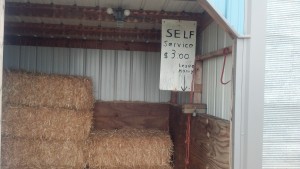2013 Winter Wheat Crop: Month 8
May 31, 2013
There have been a lot of changes since we took a first look inside the wheat plant stem on May 3.
The plant now reaches about 34 inches from the ground to its tip. The seed head is fully developed, but the kernels are still soft. The kernels are now “filling” or reaching maturity. Rain is still important because it influences the weight of each kernel.
We get paid on the number of bushels. Bushels are figured by weight and the average bushel of wheat weighs 60 pounds. The cash price for wheat this morning is $7.30 per bushel. Our yield will be the true indicator of the effect of the late freezes.
You can see how the plants are losing their green color as they complete the life cycle. The kernels will harden and the plant will turn golden as it dries down, or essentially, dies.
We begin harvest when we’re sure that the seed kernel is dry enough. Kernels that are too wet would eventually spoil. So, the grain companies that receive the wheat have set limits on moisture content.
Take a look at month 8. Next month: Harvest!
Moved Away: The Old Kohler Place
May 10, 2013
First Look at Wheat Yield
May 3, 2013
Here’s what we saw when we opened a wheat plant to see the head (seed structure). It’s too early to confirm yields and what the effect might be from the three late freezes, but so far, so good. The yield is measured by bushel. For wheat, each bushel is figured at 60 pounds of wheat seeds.
Leave Money Here
April 30, 2013
2013 Winter Wheat Crop: Month 7 Update
April 11, 2013
Good news, we think. The temperatures didn’t go below 29 degrees last night. That’s a little buffer above the 24-degree mark, where K-State Extension says the real damage occurs at this stage. Plus, the freezing rain was more moisture.
The frozen wheat of yesterday looks a more cheery version of crystallized this morning. Here’s a view from across the road.
2013 Winter Wheat Crop: Month 7
April 10, 2013
A spring threat has become a reality. Our wheat crop is coated with ice. This is not good news for a plant that is out of dormancy and growing. The crop at this stage of growth is referred to as jointing. This chart from the University of Illinois Extension shows the different stages.
The smart folks at our own state Extension Service (Kansas State University) describe the effect of freezing temperatures at the jointing stage:
-
Approximate injurious temperature for two hours: -24 F.
-
Primary Symptoms: Death of growing point; leaf yellowing or burning; lesions, splitting, or bending of lower stem; odor
-
Yield effect: Moderate to severe
We do expect some reduction in yield, but it’s hard to predict much beyond that. Modern seed varieties are nothing short of amazing in their ability to survive extremes. The same could be said for the farmer and his crops.
For now, we’ll keep one eye on the fields and another on the temperature gauge.
2013 Winter Wheat Crop: Month 6
March 24, 2013
Gloomy skies may not be good for the soul, but they are good for our wheat fields right now. The wheat plants have broken their winter dormancy. We want the growth now to be steady, not speeded up by unseasonably warm temperatures.
We’re still worried about the drought, so we were glad for yesterday’s mist and snow flurries. Today, a surprise snow storm blew in. It’s hard to tell how much snow we received because of the drifting. Maybe about three inches or so. This latest moisture will definitely help, especially since the wheat is now growing.
We’re still way behind in terms of moisture, however. The National Drought Mitigation Center says Kansas needs 12 to 16 inches of water to fully recover from the drought. This state has crazy weather, so hope that doesn’t come all at once!
Take a look at month 6:
Calling All Eaters
March 19, 2013
Happy Ag Day everyone!
I thought I’d share the presentation I did for TEDxICT last year, “Calling All Eaters.” Hope it provides some insights into ways we all can connect with agriculture.
As the U.S. Department of Agriculture says, “Every family needs a farmer.” I’d like to add that every farmer needs a family. Together, we feed the world.
Also, here’s a link to the slides in the talk, http://www.linkedin.com/profile/view?id=7341369&trk=tab_pro.
Thanks for reading and watching.
















